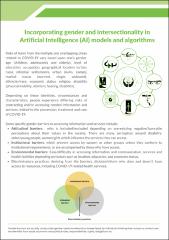Incorporating Gender and Intersectionality In Artificial Intelligence (AI) Models and Algorithms
| dc.contributor.author | Muyingo, Sylvia | |
| dc.contributor.author | Mbuthia, Michelle | |
| dc.date.accessioned | 2023-08-30T10:57:59Z | |
| dc.date.available | 2023-08-30T10:57:59Z | |
| dc.date.issued | 2022-10 | |
| dc.identifier.uri | http://10.176.203.77/handle/123456789/286 | |
| dc.description.abstract | Risks of harm from the multiple and overlapping crises related to COVID-19 vary based upon one’s gender, age (children, adolescents and elderly), level of education, occupation, geographical location (urban, rural, informal settlements, urban slums, camps), marital status (married, single, widowed), ethnicity/race, economic status, religion, disability (physical mobility, albinism, hearing. disability). Depending on these identities, circumstances and characteristics, people experience differing risks of contracting and/or accessing needed information and services related to the prevention, treatment and care of COVID-19. | en_US |
| dc.language.iso | en_US | en_US |
| dc.publisher | APHRC | en_US |
| dc.subject | Data | en_US |
| dc.subject | Measurement | en_US |
| dc.subject | Evaluation | en_US |
| dc.subject | Artificial Intelligence | en_US |
| dc.subject | Intersectionality | en_US |
| dc.subject | Checklist | en_US |
| dc.subject | COVID-19 | en_US |
| dc.title | Incorporating Gender and Intersectionality In Artificial Intelligence (AI) Models and Algorithms | en_US |
| dc.type | Working Paper | en_US |
Files in this item
This item appears in the following Collection(s)
-
2022 [26]

